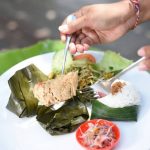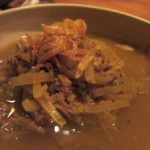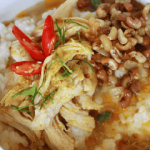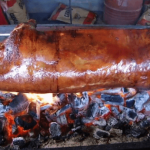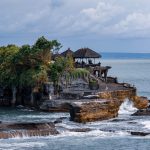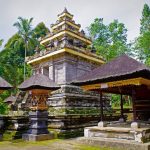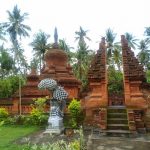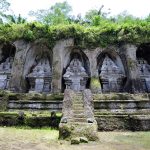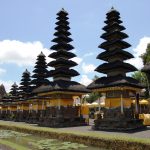Bali
Bali
Bali Dwipa Jaya - Jayalah Pulau Bali - Live the island of Bali
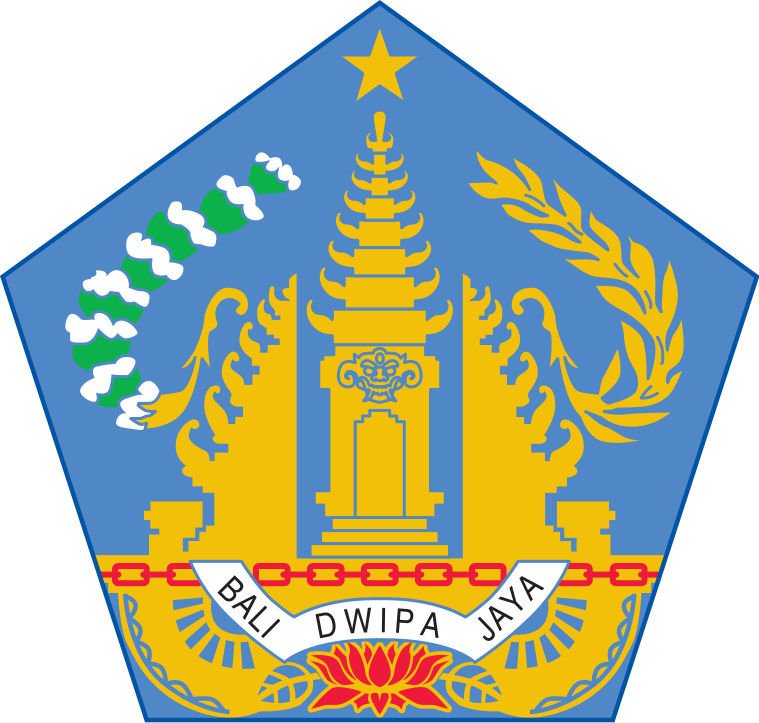
Bali (/ˈbɑːli/) (Balinese: ᬩᬮᬶ) is a province of Indonesia and the westernmost of the Lesser Sunda Islands. East of Java and west of Lombok, the province includes the island of Bali and a few smaller neighbouring islands, notably Nusa Penida, Nusa Lembongan, and Nusa Ceningan.
The provincial capital, Denpasar, is the most populous city in the Lesser Sunda Islands and the second-largest, after Makassar, in Eastern Indonesia. Bali is Indonesia’s main tourist destination, with a significant rise in tourism since the 1980s. Tourism-related business makes up 80% of its economy.
Bali is part of the Coral Triangle, the area with the highest biodiversity of marine species especially fish and turtles. In this area alone, over 500 reef-building coral species can be found. For comparison, this is about seven times as many as in the entire Caribbean. Bali is the home of the Subak irrigation system, a UNESCO World Heritage Site. It is also home to a unified confederation of kingdoms composed of 10 traditional royal Balinese houses, each house ruling a specific geographic area. The confederation is the successor of the Bali Kingdom. The royal houses are not recognised by the government of Indonesia; however, they originated before Dutch colonisation.
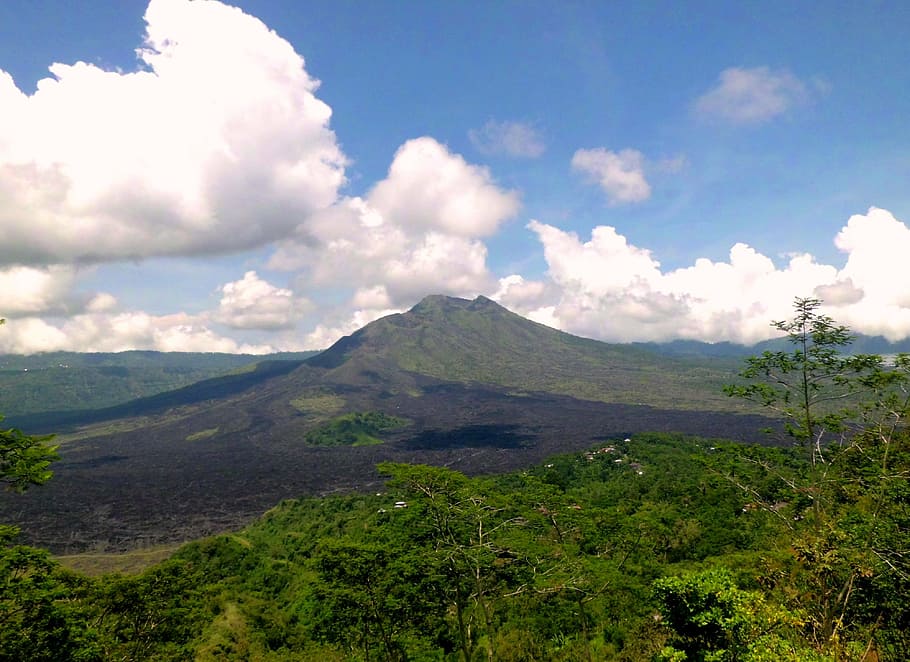 Geography
Geography
The island of Bali lies 3.2 km (2.0 mi) east of Java, and is approximately 8 degrees south of the equator. Bali and Java are separated by the Bali Strait.
East to west, the island is approximately 153 km (95 mi) wide and spans approximately 112 km (70 mi) north to south; administratively it covers 5,780 km2 (2,230 sq mi), or 5,577 km2 (2,153 sq mi) without Nusa Penida District; its population density is roughly 750 people/km2 (1,900 people/sq mi).
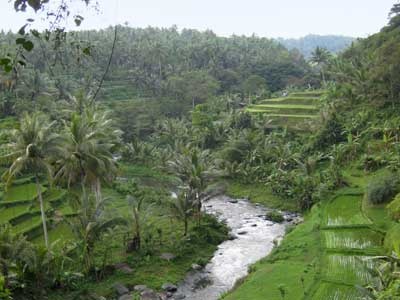 Bali’s central mountains include several peaks over 2,000 metres (6,600 feet) in elevation and active volcanoes such as Mount Batur. The highest is Mount Agung (3,031 m, 9,944 ft), known as the “mother mountain”, which is an active volcano rated as one of the world’s most likely sites for a massive eruption within the next 100 years.
Bali’s central mountains include several peaks over 2,000 metres (6,600 feet) in elevation and active volcanoes such as Mount Batur. The highest is Mount Agung (3,031 m, 9,944 ft), known as the “mother mountain”, which is an active volcano rated as one of the world’s most likely sites for a massive eruption within the next 100 years.
In late 2017 Mount Agung started erupting and large numbers of people were evacuated, temporarily closing the island’s airport. Mountains range from centre to the eastern side, with Mount Agung the easternmost peak. Bali’s volcanic nature has contributed to its exceptional fertility and its tall mountain ranges provide the high rainfall that supports the highly productive agriculture sector.
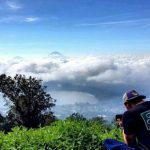
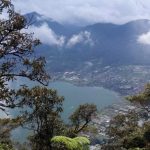








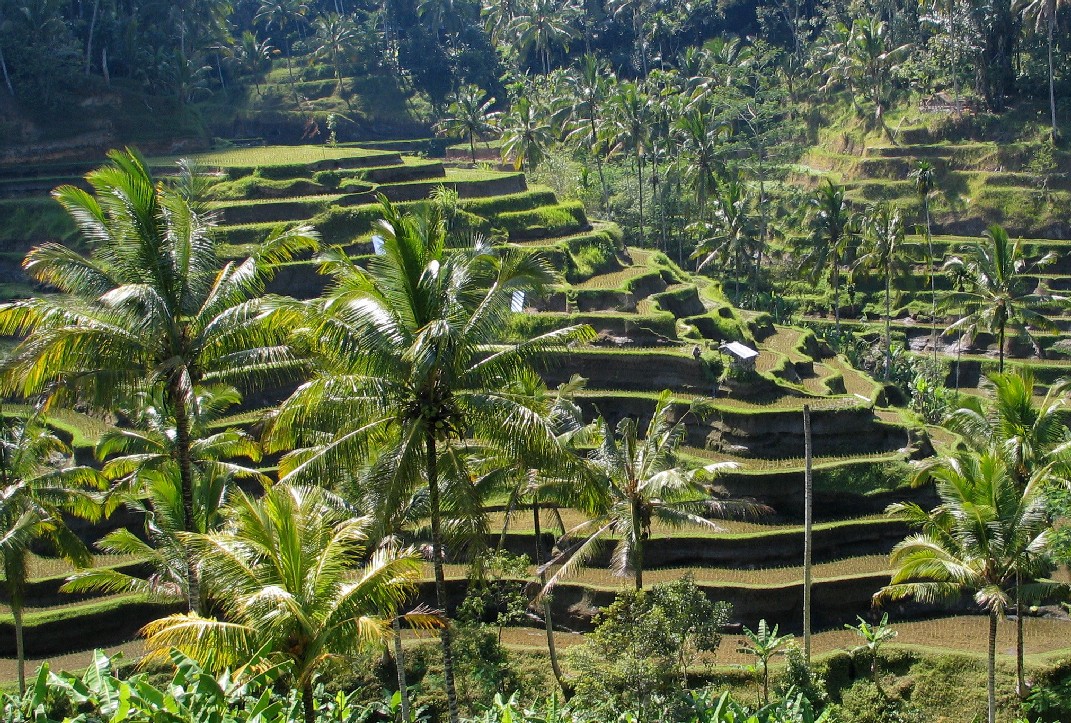 South of the mountains is a broad, steadily descending area where most of Bali’s large rice crop is grown. The northern side of the mountains slopes more steeply to the sea and is the main coffee-producing area of the island, along with rice, vegetables and cattle. The longest river, Ayung River, flows approximately 75 km (47 mi).
South of the mountains is a broad, steadily descending area where most of Bali’s large rice crop is grown. The northern side of the mountains slopes more steeply to the sea and is the main coffee-producing area of the island, along with rice, vegetables and cattle. The longest river, Ayung River, flows approximately 75 km (47 mi).
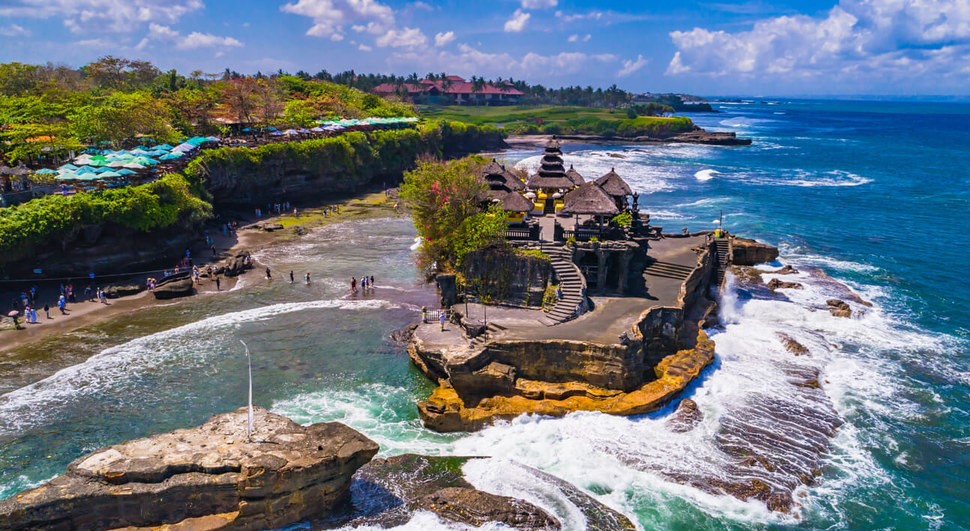 The island is surrounded by coral reefs. Beaches in the south tend to have white sand while those in the north and west have black sand. Bali has no major waterways, although the Ho River is navigable by small sampan boats. Black sand beaches between Pasut and Klatingdukuh are being developed for tourism, but apart from the seaside temple of Tanah Lot, they are not yet used for significant tourism.
The island is surrounded by coral reefs. Beaches in the south tend to have white sand while those in the north and west have black sand. Bali has no major waterways, although the Ho River is navigable by small sampan boats. Black sand beaches between Pasut and Klatingdukuh are being developed for tourism, but apart from the seaside temple of Tanah Lot, they are not yet used for significant tourism.
The largest city is the provincial capital, Denpasar, near the southern coast. Its population is around 491,500 (2002). Bali’s second-largest city is the old colonial capital, Singaraja, which is located on the north coast and is home to around 100,000 people. Other important cities include the beach resort, Kuta, which is practically part of Denpasar’s urban area, and Ubud, situated at the north of Denpasar, is the island’s cultural centre.
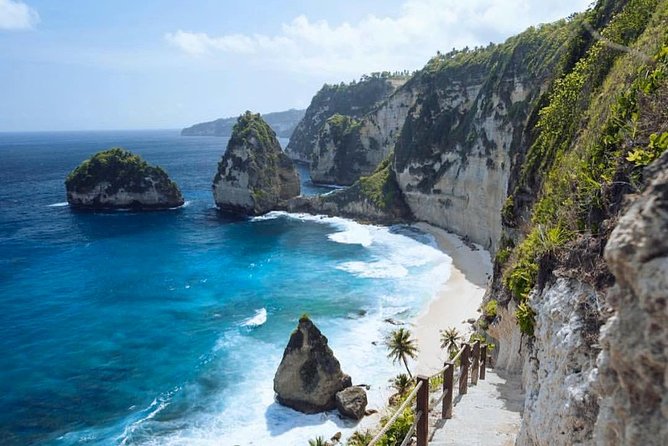 Three small islands lie to the immediate south-east and all are administratively part of the Klungkung regency of Bali: Nusa Penida, Nusa Lembongan and Nusa Ceningan. These islands are separated from Bali by the Badung Strait.
Three small islands lie to the immediate south-east and all are administratively part of the Klungkung regency of Bali: Nusa Penida, Nusa Lembongan and Nusa Ceningan. These islands are separated from Bali by the Badung Strait.
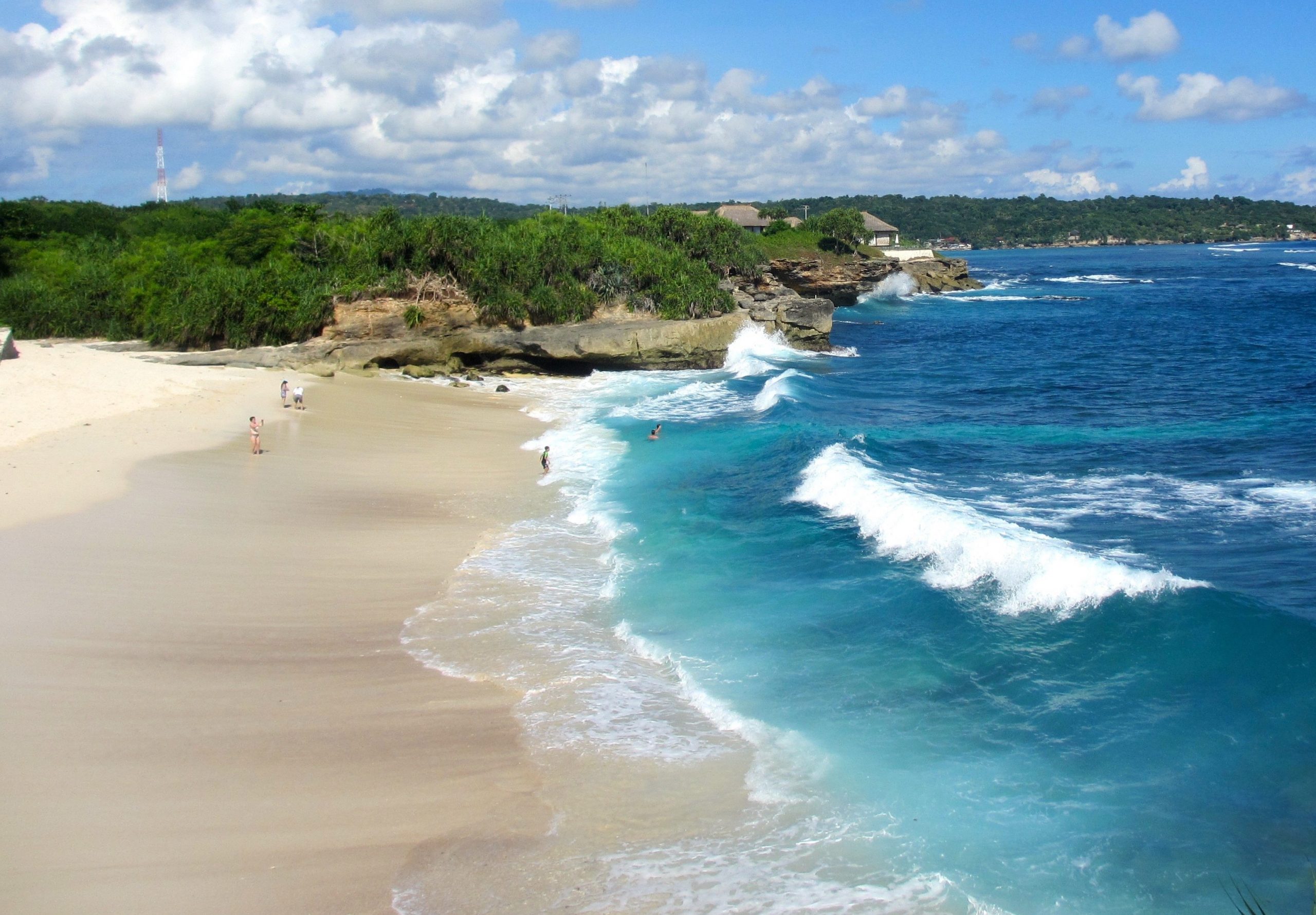 To the east, the Lombok Strait separates Bali from Lombok and marks the biogeographical division between the fauna of the Indomalayan realm and the distinctly different fauna of Australasia. The transition is known as the Wallace Line, named after Alfred Russel Wallace, who first proposed a transition zone between these two major biomes.
To the east, the Lombok Strait separates Bali from Lombok and marks the biogeographical division between the fauna of the Indomalayan realm and the distinctly different fauna of Australasia. The transition is known as the Wallace Line, named after Alfred Russel Wallace, who first proposed a transition zone between these two major biomes.
When sea levels dropped during the Pleistocene ice age, Bali was connected to Java and Sumatra and to the mainland of Asia and shared the Asian fauna, but the deep water of the Lombok Strait continued to keep Lombok Island and the Lesser Sunda archipelago isolated.
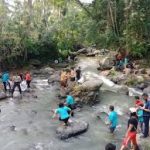
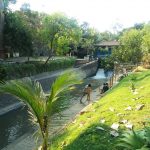
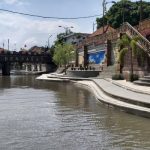
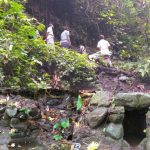
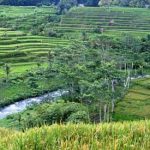

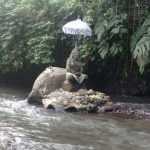

 Climate
Climate
Being just 8 degrees south of the equator, Bali has a fairly even climate all year round. Average year-round temperature stands at around 30 °C (86 °F) with a humidity level of about 85%.
Day time temperatures at low elevations vary between 20 to 33 °C (68 to 91 °F), but the temperatures decrease significantly with increasing elevation.
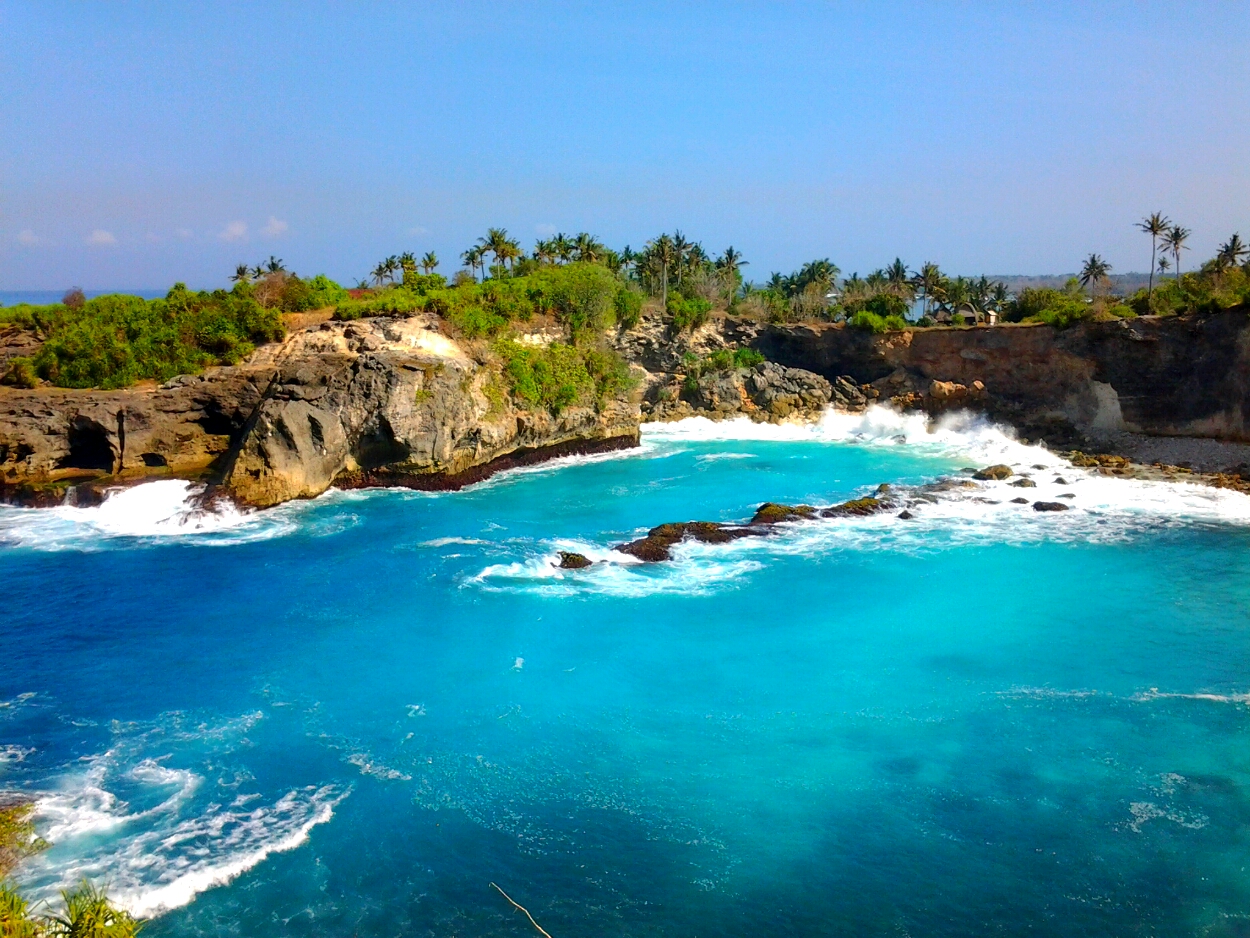 The west monsoon is in place from approximately October to April, and this can bring significant rain, particularly from December to March. During the rainy season, there are comparatively fewer tourists seen in Bali. During the Easter and Christmas holidays, the weather is very unpredictable. Outside of the monsoon period, humidity is relatively low and any rain is unlikely in lowland areas.
The west monsoon is in place from approximately October to April, and this can bring significant rain, particularly from December to March. During the rainy season, there are comparatively fewer tourists seen in Bali. During the Easter and Christmas holidays, the weather is very unpredictable. Outside of the monsoon period, humidity is relatively low and any rain is unlikely in lowland areas.
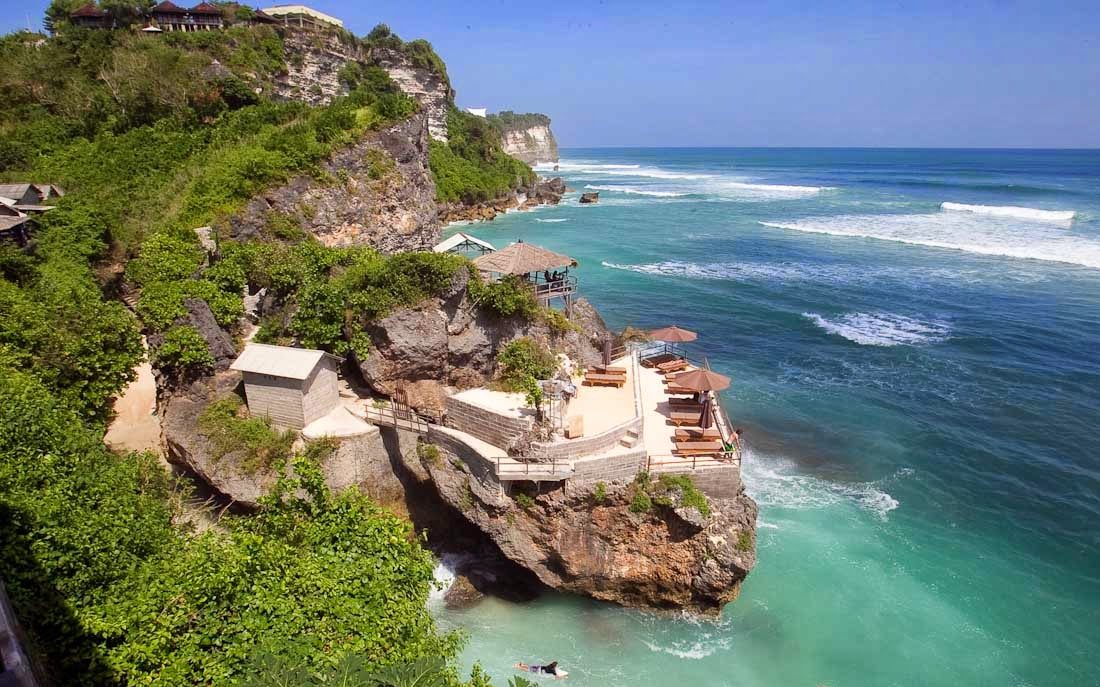 Ecology
Ecology
Bali lies just to the west of the Wallace Line, and thus has a fauna that is Asian in character, with very little Australasian influence, and has more in common with Java than with Lombok. An exception is the yellow-crested cockatoo, a member of a primarily Australasian family.
There are around 280 species of birds, including the critically endangered Bali myna, which is endemic.
Others include barn swallow, black-naped oriole, black racket-tailed treepie, crested serpent-eagle, crested treeswift, dollarbird, Java sparrow, lesser adjutant, long-tailed shrike, milky stork, Pacific swallow, red-rumped swallow, sacred kingfisher, sea eagle, woodswallow, savanna nightjar, stork-billed kingfisher, yellow-vented bulbul and great egret.

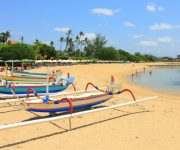
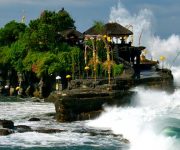
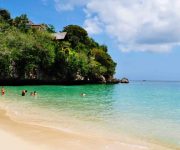




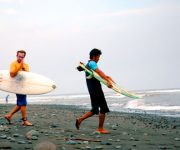
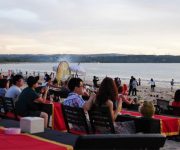
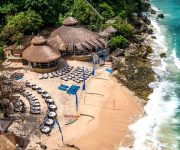





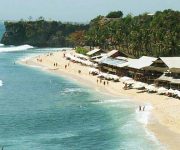




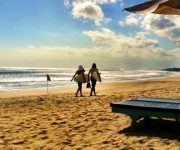

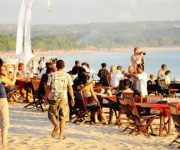
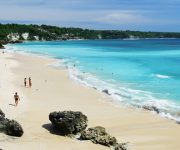
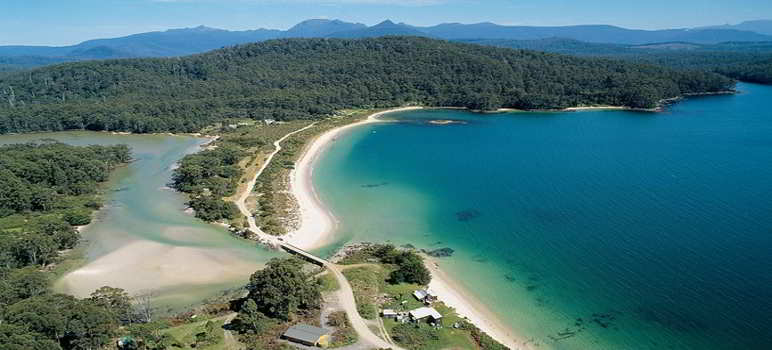 Until the early 20th century, Bali was possibly home to several large mammals: leopard and the endemic Bali tiger. The banteng still occurs in its domestic form, whereas leopards are found only in neighbouring Java, and the Bali tiger is extinct.
Until the early 20th century, Bali was possibly home to several large mammals: leopard and the endemic Bali tiger. The banteng still occurs in its domestic form, whereas leopards are found only in neighbouring Java, and the Bali tiger is extinct.
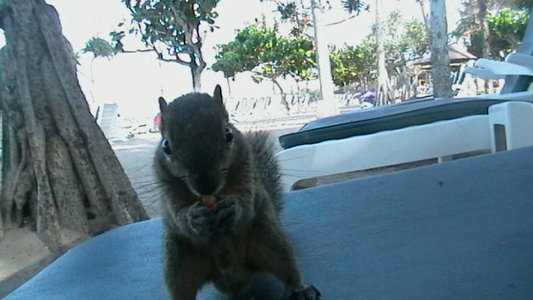 The last definite record of a tiger on Bali dates from 1937, when one was shot, though the subspecies may have survived until the 1940s or 1950s. Pleistocene and Holocene megafaunas include banteng and giant tapir (based on speculations that they might have reached up to the Wallace Line), elephants, and rhinoceros.
The last definite record of a tiger on Bali dates from 1937, when one was shot, though the subspecies may have survived until the 1940s or 1950s. Pleistocene and Holocene megafaunas include banteng and giant tapir (based on speculations that they might have reached up to the Wallace Line), elephants, and rhinoceros.
Squirrels are quite commonly encountered, less often is the Asian palm civet, which is also kept in coffee farms to produce kopi luwak. Bats are well represented, perhaps the most famous place to encounter them remaining is the Goa Lawah (Temple of the Bats) where they are worshipped by the locals and also constitute a tourist attraction.
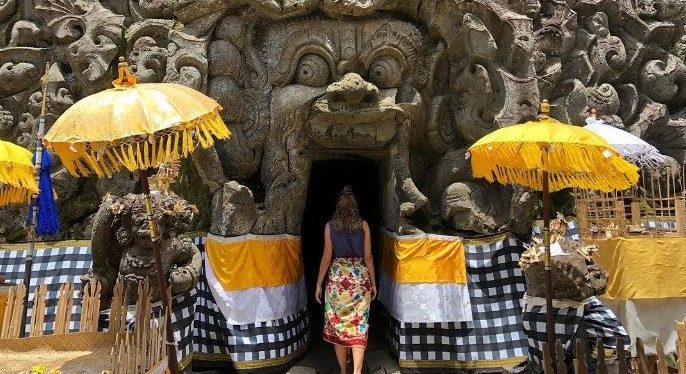
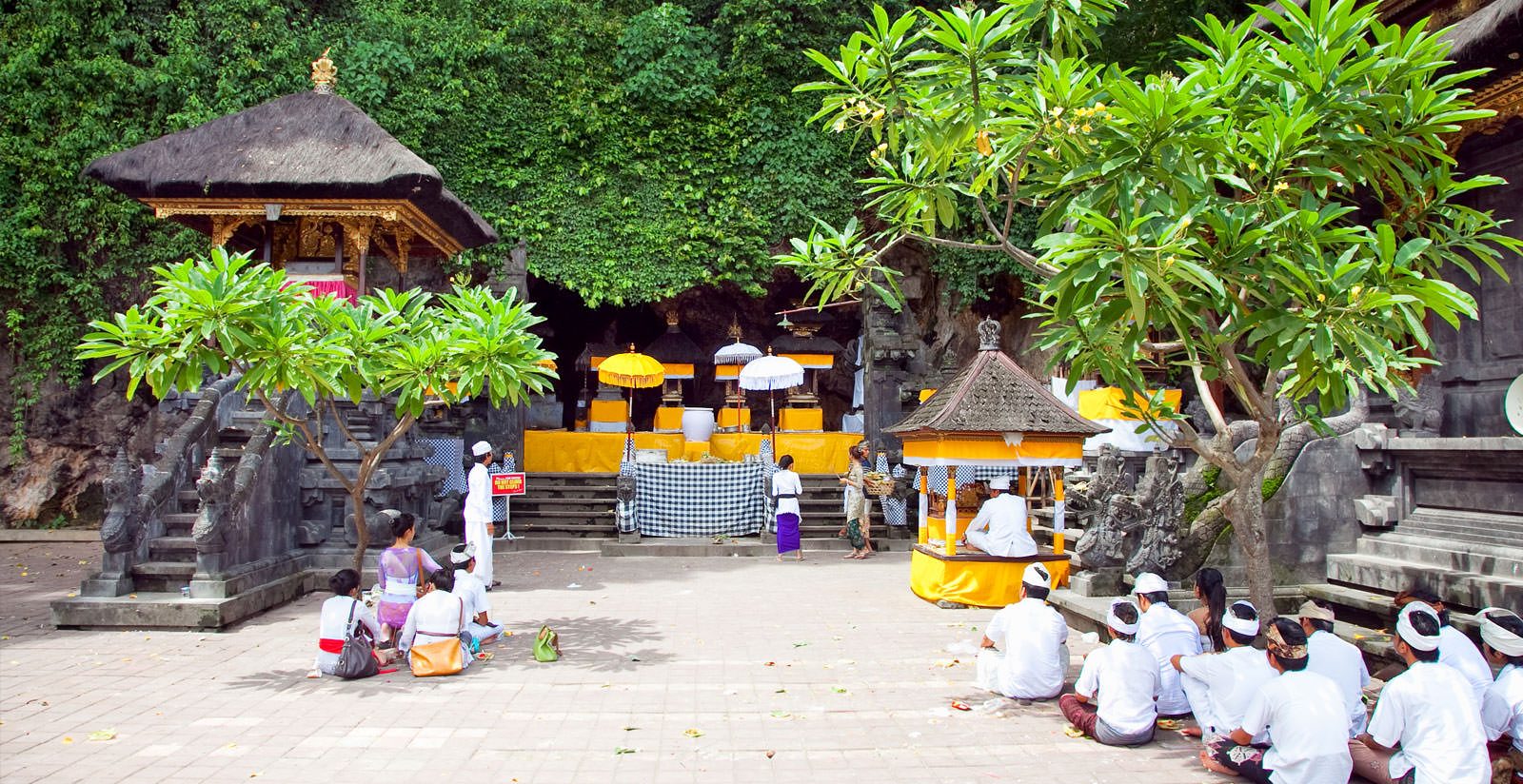 They also occur in other cave temples, for instance at Gangga Beach. Two species of monkey occur. The crab-eating macaque, known locally as “kera”, is quite common around human settlements and temples, where it becomes accustomed to being fed by humans, particularly in any of the three “monkey forest” temples, such as the popular one in the Ubud area.
They also occur in other cave temples, for instance at Gangga Beach. Two species of monkey occur. The crab-eating macaque, known locally as “kera”, is quite common around human settlements and temples, where it becomes accustomed to being fed by humans, particularly in any of the three “monkey forest” temples, such as the popular one in the Ubud area.
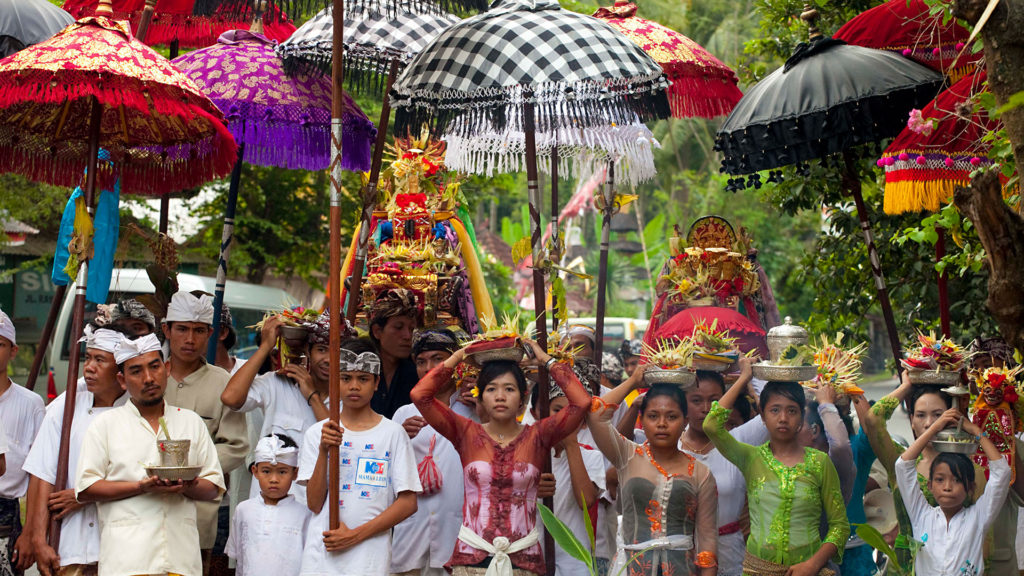 Caste System
Caste System
The island of Bali has a system of social organization similar to the Indian caste system. The four castes of Bali are:
Sudras (Shudras) – peasants making up more than 90% of Bali’s population. They constitute close to 93% of the population.
Wesias (Vaishyas) – the caste of merchants and administrative officials.
Satrias (Kshatriyas) – the warriors caste, it also included some nobility and kings.
Brahmanas (Brahmins) – the priests caste.
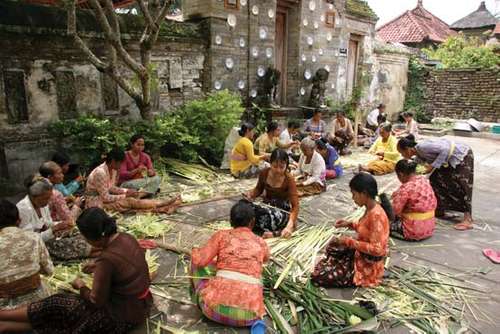 Note the similarity of the castes to the four varnas (shudra, vaishya, kshatriya, brahmin) of India.
Note the similarity of the castes to the four varnas (shudra, vaishya, kshatriya, brahmin) of India.
Pre-modern Bali had four castes, as Jeff Lewis and Belinda Lewis state, but with a “very strong tradition of communal decision-making and interdependence”. The four castes have been classified as Sudra (Shudra), Wesia (Vaishyas), Satria (Kshatriyas) and Brahmana (Brahmin).
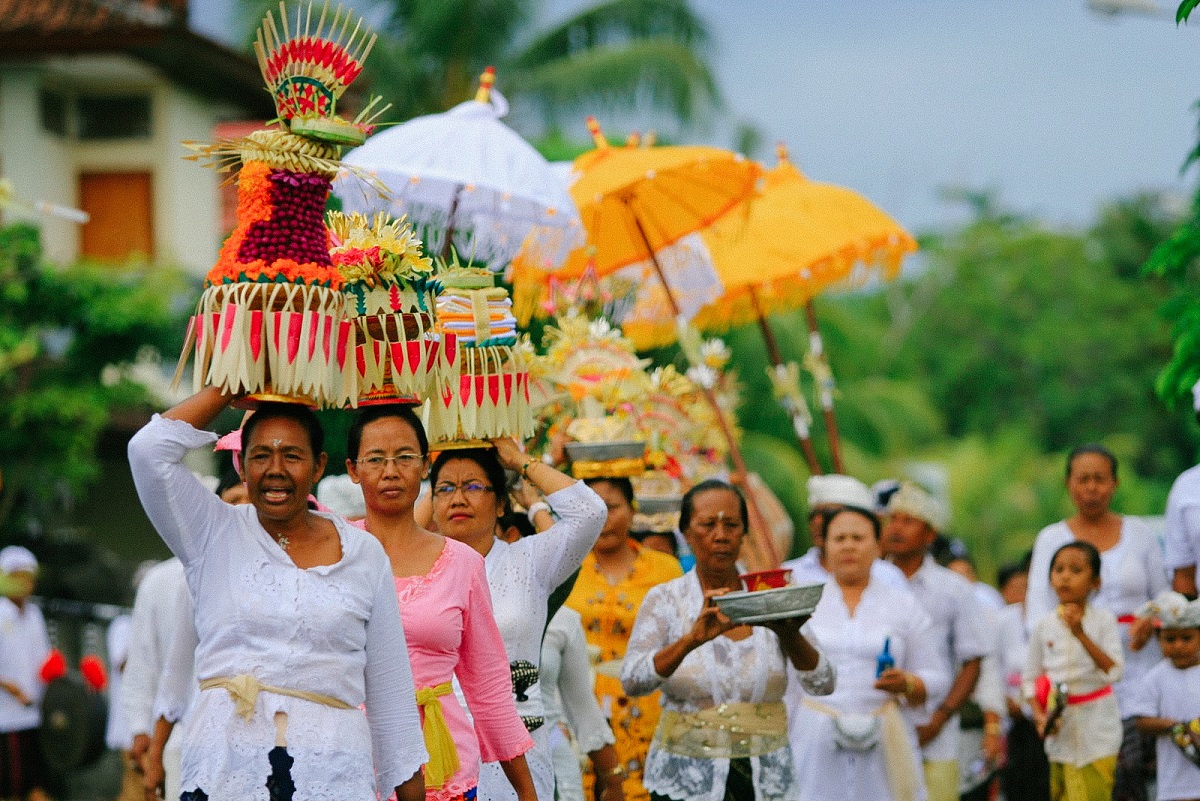 The 19th-century scholars such as Crawfurd and Friederich suggested that the Balinese caste system had Indian origins, but Helen Creese states that scholars such as Brumund who had visited and stayed on the island of Bali suggested that his field observations conflicted with the “received understandings concerning its Indian origins”.
The 19th-century scholars such as Crawfurd and Friederich suggested that the Balinese caste system had Indian origins, but Helen Creese states that scholars such as Brumund who had visited and stayed on the island of Bali suggested that his field observations conflicted with the “received understandings concerning its Indian origins”.
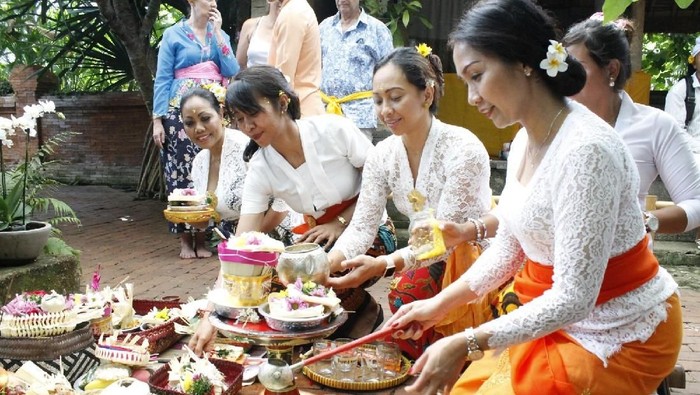 In Bali, the Shudra (locally spelled Soedra) have typically been the temple priests, though depending on the demographics, a temple priest may also be from the other three castes.
In Bali, the Shudra (locally spelled Soedra) have typically been the temple priests, though depending on the demographics, a temple priest may also be from the other three castes.
In most regions, it has been the Shudra who typically make offerings to the gods on behalf of the Hindu devotees, chant prayers, recite meweda (Vedas), and set the course of Balinese temple festivals.
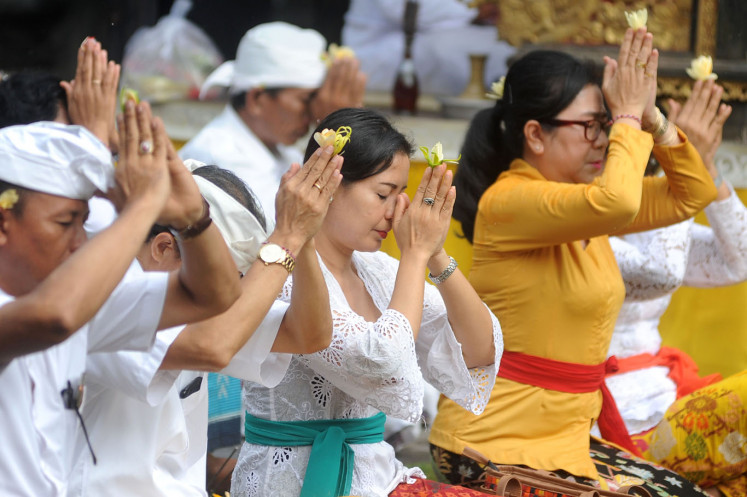 The members of the four castes use different levels of the Balinese language to address members of a different caste. Middle Balinese is generally used to speak to people whose caste is unknown in an encounter. Once the caste status of the participants are established, the proper language is used to address each other.
The members of the four castes use different levels of the Balinese language to address members of a different caste. Middle Balinese is generally used to speak to people whose caste is unknown in an encounter. Once the caste status of the participants are established, the proper language is used to address each other.
 Nowadays, the caste system is used more in religious settings where the members of the lower caste would ask the members of the Brahman caste (the Pedandas) to conduct ceremonies. Since the Dutch colonial years and more recently after the Indonesian independence, the differences in the economic roles of the members of the caste system are slowly eroding as the government prohibits treatments based on the caste system.
Nowadays, the caste system is used more in religious settings where the members of the lower caste would ask the members of the Brahman caste (the Pedandas) to conduct ceremonies. Since the Dutch colonial years and more recently after the Indonesian independence, the differences in the economic roles of the members of the caste system are slowly eroding as the government prohibits treatments based on the caste system.
Most of the Kshatriya families in Java and Bali became extinct during the fall of the Majapahit and the numerous Javanese wars. Almost all of the Balinese Kshatriyas trace their origin to the royal family of King Deva Agung, who ruled 500 years before. Some of the original Kshatriyas, such as those claiming descent from Arya Damar, were relegated to Wesia status, so only those claiming descent from Deva Agung are recognized as proper Kshatriya in Bali.

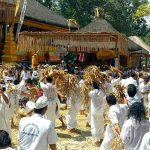
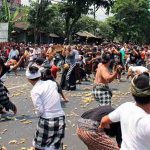
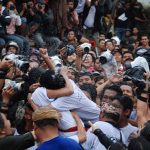
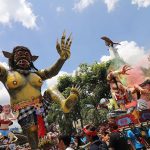
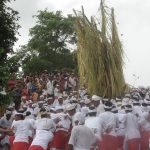

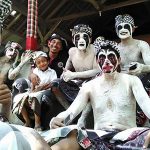
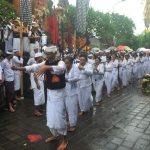
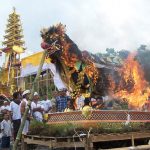

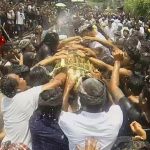


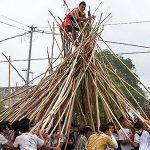
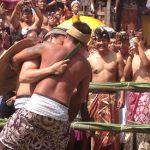

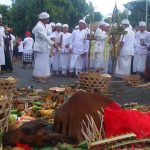
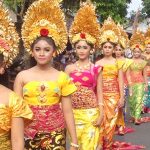
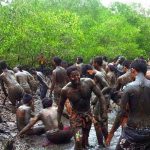
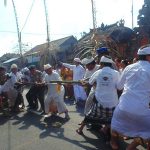

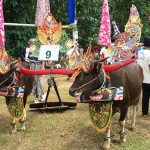
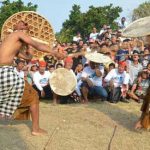
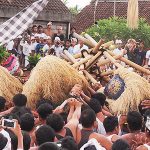
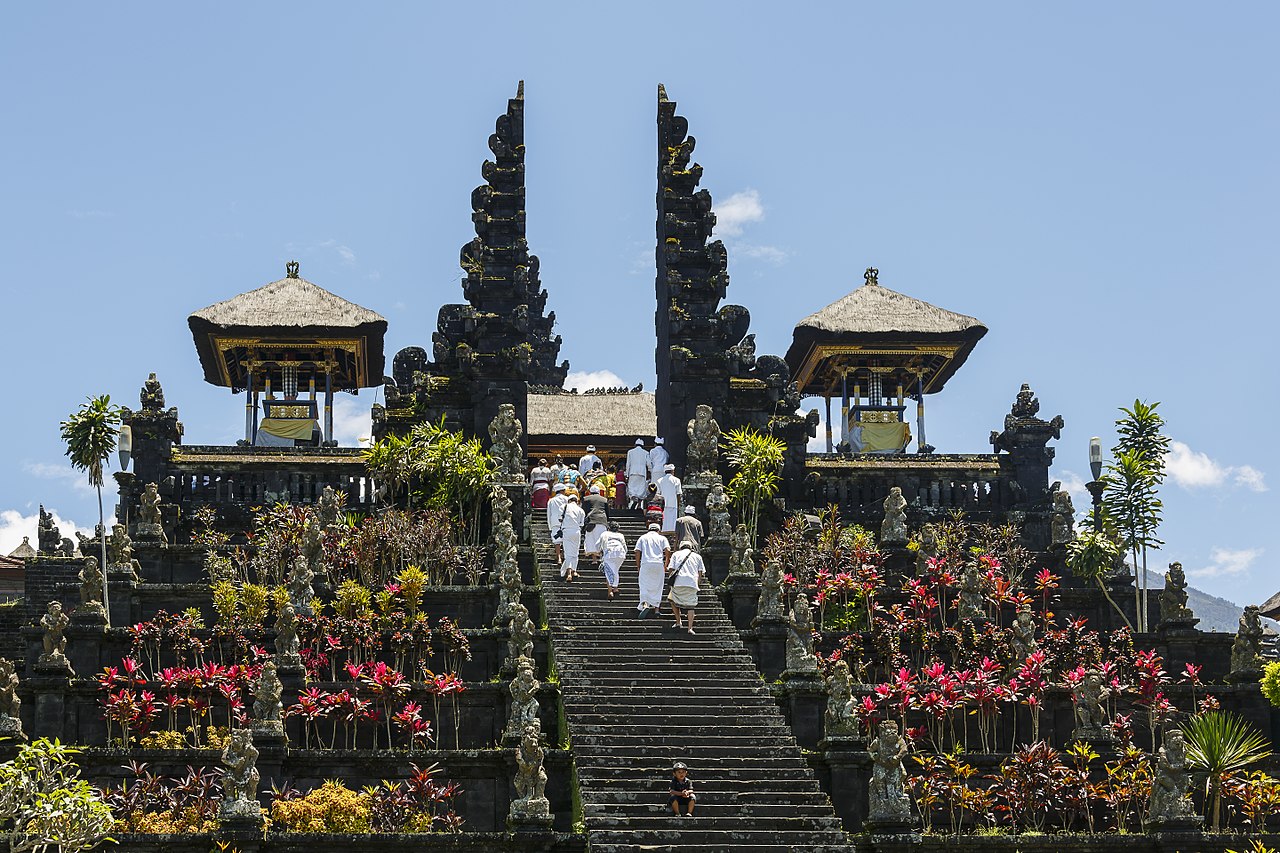 Religion
Religion
Unlike most of Muslim-majority Indonesia, about 83.5% of Bali’s population adheres to Balinese Hinduism, formed as a combination of existing local beliefs and Hindu influences from mainland Southeast Asia and South Asia. Minority religions include Islam (13.37%), Christianity (2.47%), and Buddhism (0.5%).
The general beliefs and practices of Agama Hindu Dharma mix ancient traditions and contemporary pressures placed by Indonesian laws that permit only monotheist belief under the national ideology of Pancasila. Traditionally, Hinduism in Indonesia had a pantheon of deities and that tradition of belief continues in practice; further, Hinduism in Indonesia granted freedom and flexibility to Hindus as to when, how and where to pray.
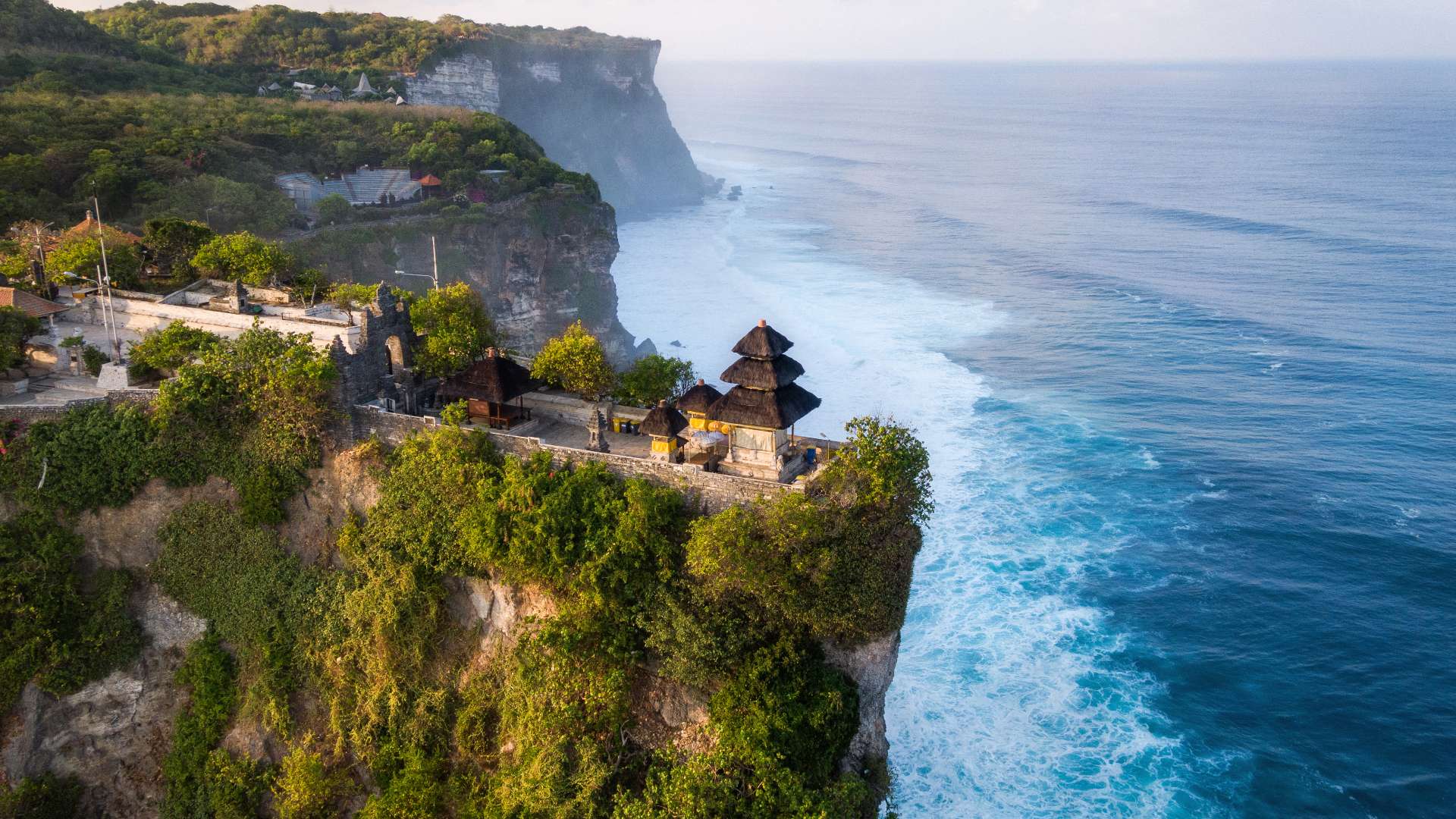 However, officially, the Indonesian government considers and advertises Indonesian Hinduism as a monotheistic religion with certain officially recognised beliefs that comply with its national ideology. Indonesian school textbooks describe Hinduism as having one supreme being, Hindus offering three daily mandatory prayers, and Hinduism as having certain common beliefs that in part parallel those of Islam. Scholars contest whether these Indonesian government recognised and assigned beliefs to reflect the traditional beliefs and practices of Hindus in Indonesia before Indonesia gained independence from Dutch colonial rule.
However, officially, the Indonesian government considers and advertises Indonesian Hinduism as a monotheistic religion with certain officially recognised beliefs that comply with its national ideology. Indonesian school textbooks describe Hinduism as having one supreme being, Hindus offering three daily mandatory prayers, and Hinduism as having certain common beliefs that in part parallel those of Islam. Scholars contest whether these Indonesian government recognised and assigned beliefs to reflect the traditional beliefs and practices of Hindus in Indonesia before Indonesia gained independence from Dutch colonial rule.
 Balinese Hinduism has roots in Indian Hinduism and Buddhism, that arrived through Java. Hindu influences reached the Indonesian Archipelago as early as the first century. Historical evidence is unclear about the diffusion process of cultural and spiritual ideas from India. Java legends refer to Saka-era, traced to 78 CE. Stories from the Mahabharata Epic have been traced in Indonesian islands to the 1st century; however, the versions mirror those found in southeast Indian peninsular region (now Tamil Nadu and southern Karnataka Andhra Pradesh).
Balinese Hinduism has roots in Indian Hinduism and Buddhism, that arrived through Java. Hindu influences reached the Indonesian Archipelago as early as the first century. Historical evidence is unclear about the diffusion process of cultural and spiritual ideas from India. Java legends refer to Saka-era, traced to 78 CE. Stories from the Mahabharata Epic have been traced in Indonesian islands to the 1st century; however, the versions mirror those found in southeast Indian peninsular region (now Tamil Nadu and southern Karnataka Andhra Pradesh).
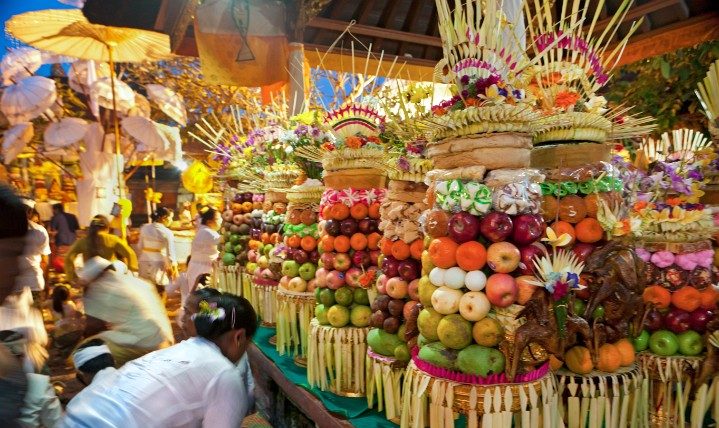 The Bali tradition adopted the pre-existing animistic traditions of the indigenous people. This influence strengthened the belief that the gods and goddesses are present in all things. Every element of nature, therefore, possesses its power, which reflects the power of the gods. A rock, tree, dagger, or woven cloth is a potential home for spirits whose energy can be directed for good or evil. Balinese Hinduism is deeply interwoven with art and ritual. Ritualising states of self-control are a notable feature of religious expression among the people, who for this reason have become famous for their graceful and decorous behaviour.
The Bali tradition adopted the pre-existing animistic traditions of the indigenous people. This influence strengthened the belief that the gods and goddesses are present in all things. Every element of nature, therefore, possesses its power, which reflects the power of the gods. A rock, tree, dagger, or woven cloth is a potential home for spirits whose energy can be directed for good or evil. Balinese Hinduism is deeply interwoven with art and ritual. Ritualising states of self-control are a notable feature of religious expression among the people, who for this reason have become famous for their graceful and decorous behaviour.
 Apart from the majority of Balinese Hindus, there also exist Chinese immigrants whose traditions have melded with that of the locals. As a result, these Sino-Balinese not only embrace their original religion, which is a mixture of Buddhism, Christianity, Taoism and Confucianism but also find a way to harmonise it with the local traditions. Hence, it is not uncommon to find local Sino-Balinese during the local temple’s odalan.
Apart from the majority of Balinese Hindus, there also exist Chinese immigrants whose traditions have melded with that of the locals. As a result, these Sino-Balinese not only embrace their original religion, which is a mixture of Buddhism, Christianity, Taoism and Confucianism but also find a way to harmonise it with the local traditions. Hence, it is not uncommon to find local Sino-Balinese during the local temple’s odalan.
Moreover, Balinese Hindu priests are invited to perform rites alongside a Chinese priest in the event of the death of a Sino-Balinese. Nevertheless, the Sino-Balinese claim to embrace Buddhism for administrative purposes, such as their Identity Cards. The Roman Catholic community has a diocese, the Diocese of Denpasar that encompasses the province of Bali and West Nusa Tenggara and has its cathedral located in Denpasar.
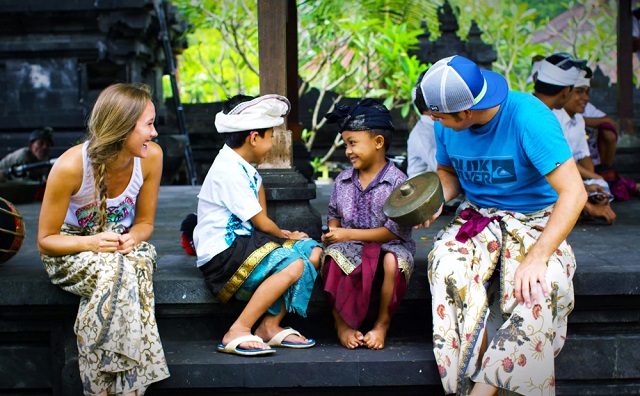 Language
Language
Balinese and Indonesian are the most widely spoken languages in Bali, and the vast majority of Balinese people are bilingual or trilingual. The most common spoken language around the tourist areas is Indonesian, as many people in the tourist sector are not solely Balinese, but migrants from Java, Lombok, Sumatra, and other parts of Indonesia.
 There are several indigenous Balinese languages, but most Balinese can also use the most widely spoken option: modern common Balinese. The usage of different Balinese languages was traditionally determined by the Balinese caste system and by clan membership, but this tradition is diminishing. Kawi and Sanskrit are also commonly used by some Hindu priests in Bali, as Hindu literature was mostly written in Sanskrit.
There are several indigenous Balinese languages, but most Balinese can also use the most widely spoken option: modern common Balinese. The usage of different Balinese languages was traditionally determined by the Balinese caste system and by clan membership, but this tradition is diminishing. Kawi and Sanskrit are also commonly used by some Hindu priests in Bali, as Hindu literature was mostly written in Sanskrit.
English and Chinese are the next most common languages (and the primary foreign languages) of many Balinese, owing to the requirements of the tourism industry, as well as the English-speaking community and huge Chinese-Indonesian population. Other foreign languages, such as Japanese, Korean, French, Russian or German are often used in multilingual signs for foreign tourists.
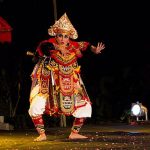
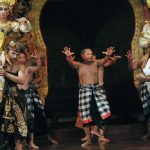
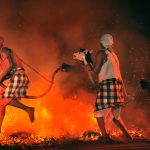
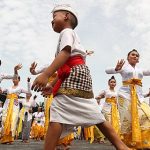

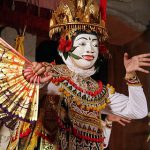



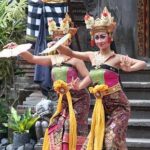
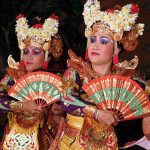
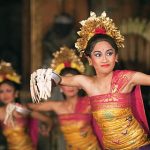
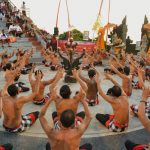

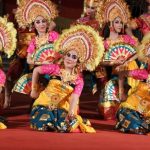
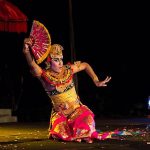

 Culture
Culture
Bali is renowned for its diverse and sophisticated art forms, such as painting, sculpture, woodcarving, handcrafts, and performing arts. Balinese cuisine is also distinctive. Balinese percussion orchestra music, known as gamelan, is highly developed and varied. Balinese performing arts often portray stories from Hindu epics such as the Ramayana but with heavy Balinese influence.
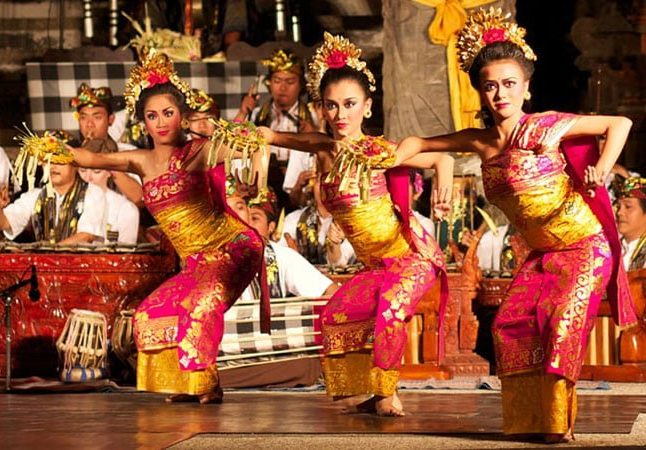 Famous Balinese dances include pendet, legong, baris, topeng, barong, gong keybar, and kecak (the monkey dance). Bali boasts one of the most diverse and innovative performing arts cultures in the world, with paid performances at thousands of temple festivals, private ceremonies, or public shows.
Famous Balinese dances include pendet, legong, baris, topeng, barong, gong keybar, and kecak (the monkey dance). Bali boasts one of the most diverse and innovative performing arts cultures in the world, with paid performances at thousands of temple festivals, private ceremonies, or public shows.
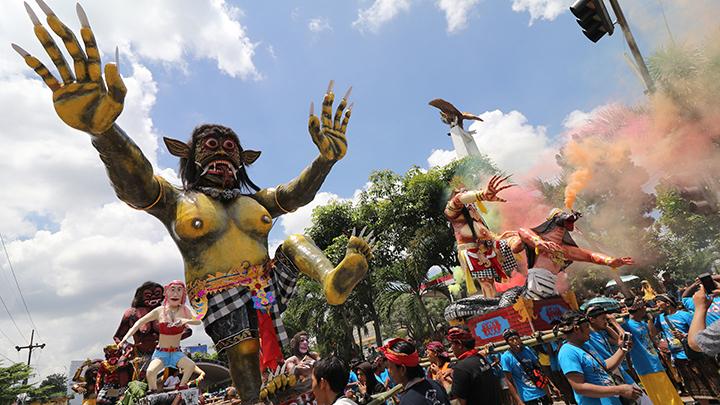 Festivals
Festivals
Throughout the year, there are a number of festivals celebrated locally or island-wide according to the traditional calendars.
The Hindu New Year, Nyepi, is celebrated in the spring by a day of silence. On this day everyone stays at home and tourists are encouraged (or required) to remain in their hotels. On the day before New Year, large and colourful sculptures of Ogoh-ogoh monsters are paraded and burned in the evening to drive away evil spirits. Other festivals throughout the year are specified by the Balinese pawukon calendrical system.
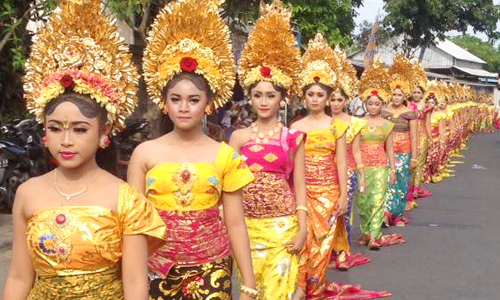 Celebrations are held for many occasions such as a tooth-filing (coming-of-age ritual), cremation or odalan (temple festival). One of the most important concepts that Balinese ceremonies have in common is that of désa kala patra, which refers to how ritual performances must be appropriate in both the specific and general social context. Many of the ceremonial art forms such as wayang kulit and topeng are highly improvisatory, providing flexibility for the performer to adapt the performance to the current situation.
Celebrations are held for many occasions such as a tooth-filing (coming-of-age ritual), cremation or odalan (temple festival). One of the most important concepts that Balinese ceremonies have in common is that of désa kala patra, which refers to how ritual performances must be appropriate in both the specific and general social context. Many of the ceremonial art forms such as wayang kulit and topeng are highly improvisatory, providing flexibility for the performer to adapt the performance to the current situation.
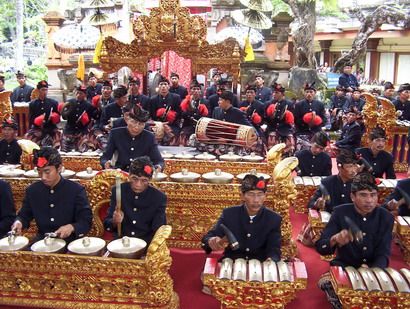 Many celebrations call for a loud, boisterous atmosphere with much activity and the resulting aesthetic, ramé, is distinctively Balinese. Often two or more gamelan ensembles will be performing well within earshot, and sometimes compete with each other to be heard. Likewise, the audience members talk amongst themselves, get up and walk around, or even cheer on the performance, which adds to the many layers of activity and the liveliness typical of ramé.
Many celebrations call for a loud, boisterous atmosphere with much activity and the resulting aesthetic, ramé, is distinctively Balinese. Often two or more gamelan ensembles will be performing well within earshot, and sometimes compete with each other to be heard. Likewise, the audience members talk amongst themselves, get up and walk around, or even cheer on the performance, which adds to the many layers of activity and the liveliness typical of ramé.
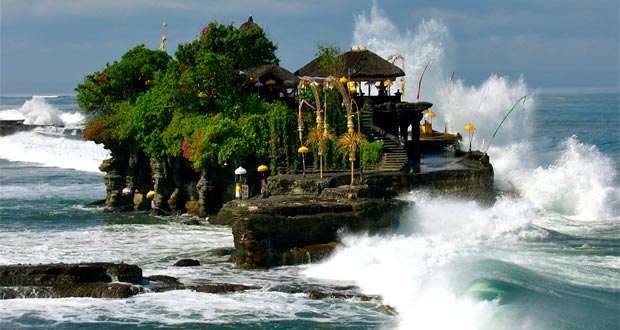 Kaja and kelod are the Balinese equivalents of North and South, which refer to one’s orientation between the island’s largest mountain Gunung Agung (kaja), and the sea (kelod). In addition to spatial orientation, kaja and kelod have the connotation of good and evil; gods and ancestors are believed to live on the mountain whereas demons live in the sea. Buildings such as temples and residential homes are spatially oriented by having the most sacred spaces closest to the mountain and the unclean places nearest to the sea.
Kaja and kelod are the Balinese equivalents of North and South, which refer to one’s orientation between the island’s largest mountain Gunung Agung (kaja), and the sea (kelod). In addition to spatial orientation, kaja and kelod have the connotation of good and evil; gods and ancestors are believed to live on the mountain whereas demons live in the sea. Buildings such as temples and residential homes are spatially oriented by having the most sacred spaces closest to the mountain and the unclean places nearest to the sea.
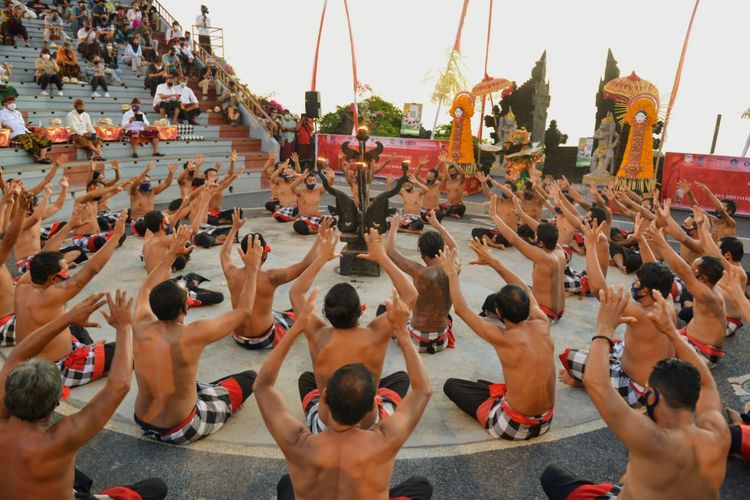 Most temples have an inner courtyard and an outer courtyard which are arranged with the inner courtyard furthest kaja. These spaces serve as performance venues since most Balinese rituals are accompanied by any combination of music, dance and drama. The performances that take place in the inner courtyard are classified as wali, the most sacred rituals which are offerings exclusively for the gods, while the outer courtyard is where bebali ceremonies are held, which are intended for gods and people.
Most temples have an inner courtyard and an outer courtyard which are arranged with the inner courtyard furthest kaja. These spaces serve as performance venues since most Balinese rituals are accompanied by any combination of music, dance and drama. The performances that take place in the inner courtyard are classified as wali, the most sacred rituals which are offerings exclusively for the gods, while the outer courtyard is where bebali ceremonies are held, which are intended for gods and people.
 Lastly, performances meant solely for the entertainment of humans take place outside the walls of the temple and are called bali-balihan. This three-tiered system of classification was standardised in 1971 by a committee of Balinese officials and artists to better protect the sanctity of the oldest and most sacred Balinese rituals from being performed for a paying audience.
Lastly, performances meant solely for the entertainment of humans take place outside the walls of the temple and are called bali-balihan. This three-tiered system of classification was standardised in 1971 by a committee of Balinese officials and artists to better protect the sanctity of the oldest and most sacred Balinese rituals from being performed for a paying audience.
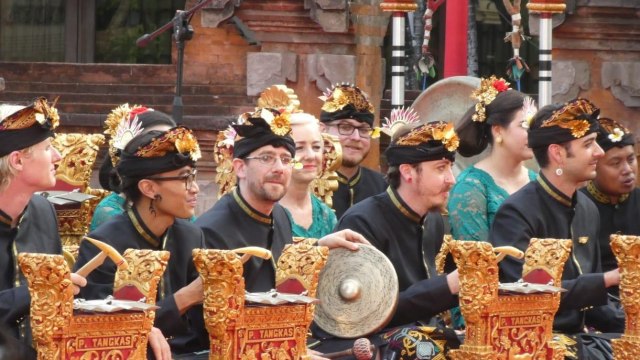 Tourism, Bali’s chief industry, has provided the island with a foreign audience that is eager to pay for entertainment, thus creating new performance opportunities and more demand for performers. The impact of tourism is controversial since before it became integrated into the economy, the Balinese performing arts did not exist as a capitalist venture, and were not performed for entertainment outside of their respective ritual context.
Tourism, Bali’s chief industry, has provided the island with a foreign audience that is eager to pay for entertainment, thus creating new performance opportunities and more demand for performers. The impact of tourism is controversial since before it became integrated into the economy, the Balinese performing arts did not exist as a capitalist venture, and were not performed for entertainment outside of their respective ritual context.
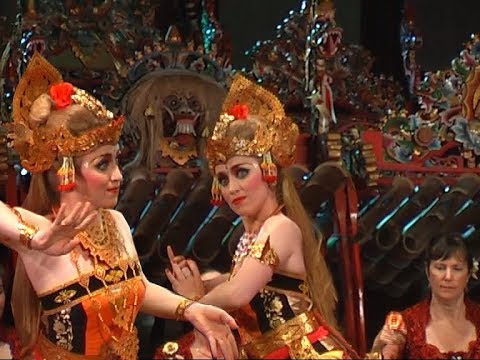 Since the 1930s sacred rituals such as the barong dance have been performed both in their original contexts, as well as exclusively for paying tourists. This has led to new versions of many of these performances which have developed according to the preferences of foreign audiences; some villages have a barong mask specifically for non-ritual performances as well as an older mask which is only used for sacred performances.
Since the 1930s sacred rituals such as the barong dance have been performed both in their original contexts, as well as exclusively for paying tourists. This has led to new versions of many of these performances which have developed according to the preferences of foreign audiences; some villages have a barong mask specifically for non-ritual performances as well as an older mask which is only used for sacred performances.
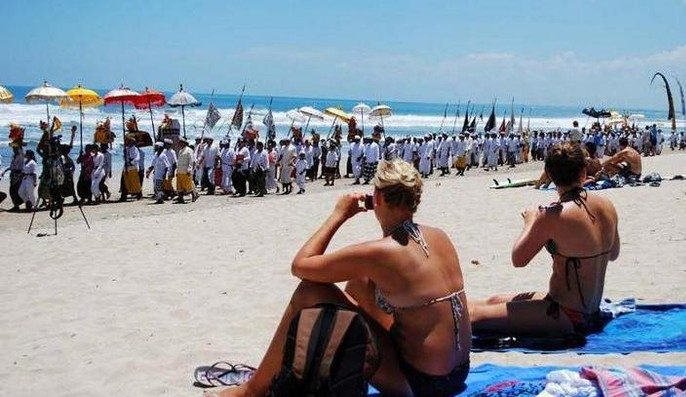 Balinese society continues to revolve around each family’s ancestral village, to which the cycle of life and religion is closely tied. Coercive aspects of traditional society, such as customary law sanctions imposed by traditional authorities such as village councils (including “kasepekang”, or shunning) have risen in importance as a consequence of the democratisation and decentralisation of Indonesia since 1998.
Balinese society continues to revolve around each family’s ancestral village, to which the cycle of life and religion is closely tied. Coercive aspects of traditional society, such as customary law sanctions imposed by traditional authorities such as village councils (including “kasepekang”, or shunning) have risen in importance as a consequence of the democratisation and decentralisation of Indonesia since 1998.
Other than Balinese sacred rituals and festivals, the government presents Bali Arts Festival to showcase Bali’s performing arts and various artworks produced by the local talents that they have. It is held once a year, from the second week of June until the end of July. Southeast Asia’s biggest annual festival of words and ideas Ubud Writers and Readers Festival is held at Ubud in October, which is participated by the world’s most celebrated writers, artists, thinkers and performers.
Kabupaten & Kotamadya
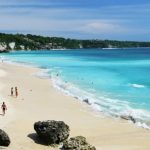
Denpasar
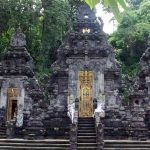
Klungkung
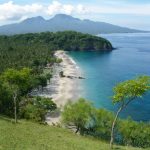
Karangasem
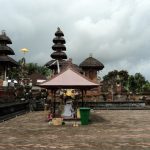
Jembrana
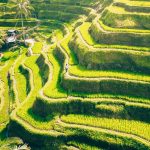
Gianyar
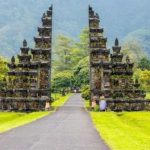
Buleleng
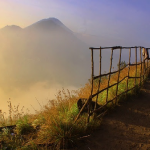
Bangli

Badung
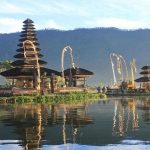
Tabanan
 Cuisine
Cuisine
Balinese cuisine is the traditional cuisine of the Balinese people from the island of Bali. Balinese cuisine is one of the most complex cuisines in the world. It uses an incredible variety of spices, mixed with fresh vegetables, meat and fish. This cuisine is a part of Indonesian cuisine, demonstrating authentic traditions, as well as influences from other regional cuisines of Indonesia, China and India.
 The island’s inhabitants are predominantly Hindu and have a somewhat different culinary tradition to other parts of Indonesia, with religious festivals and celebrations including many special meals prepared as offerings, as well as other dishes that are consumed communally during the festivities.
The island’s inhabitants are predominantly Hindu and have a somewhat different culinary tradition to other parts of Indonesia, with religious festivals and celebrations including many special meals prepared as offerings, as well as other dishes that are consumed communally during the festivities.
Rice is almost always consumed as a staple food accompanied by vegetables, meat and seafood. Pork, chicken, fruit, vegetables and seafood are widely used, but like most Hindus, Beef is never or rarely consumed.
